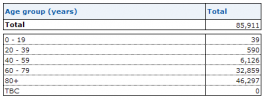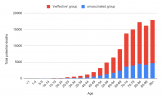Last year however we were aiming for "manageable with restrictions", this year we're aiming for no restrictions though. Superficially it's similar in that we're "opening up", but all of the restrictions that were present last summer will be going as well (in due course) - it's already less cautious than last year in my eyes if those are planned to go!
-The non-vaccine immunity is largely self-controlling I would think? The base IFR would account for that natural immunity (likelihood of anyone that age being inf I'm not trying to say "100,000 will die", just that "100,000 can ected catching it and dying), as would the efficacy of the vaccine (representing improved performance over unvaccinated). The 100% spread figure is irrelevant asdie". I agree that all of them catching it is unlikely, but the point is that we can't just "jab the vulnerable & let them be" - with the high case rates that will result from removing all restrictions without high levels of immunity, these will inevitably spread to these people. And as pointed out previously, we only need a fraction of that population to be infected to start causing problems
If you are referring to immunity by prior infection and/or cross-immunity, these numbers quickly become irrelevant in the scheme of the vaccine rollout (plus of course, many with that previous immunity will have the vaccine regardless of this pre-existing immunity), and that's before considering anything around reinfection that further complicates any sort of immunity analysis
-Not really sure about your point about the previous death numbers? I'm using them to contextualise the scale of the mortality-risk population post vaccination, it's more or less the same again as the last year. Yes the hospitals have been under immense stress, and in the event of a resurgence in cases (and hospitalisations/deaths as a result) they would be similarly stressed (and so similar sort of triaging occurring as applicable)?
-I'm not sure about "significant" further effect from a second dose - certainly with the Pfizer vaccine the increased efficacy is not particularly large, and whilst the AZ vaccine does seem to have a more significant increase in efficacy from the second dose, I don't think it'll be significant enough to change the general gist of "post vaccine rollout, there's still a large population that if infected will be hospitalised/die"
-The
IFR is certainly a big factor in this. The numbers I plugged in were taken from an
Imperial Report estimating them from multiple seroprevalence studies, and plugging in their lower bound results using the same parameters elsewhere puts out a number of 40,000 people (down 63%) but this is just being optimistic for optimisms sake. (Using upper bounds suggests a total of 355,000 for comparison sake). The with vs of issue would swing things by around 10% based on other analysis, but again this does not change the gist of "there's a lot of people out there that are not immune"
-"quickly mounting up" possibly not the best turn of phrase on my half there - 95% of the risk comes from the over 50s, but again this feels like arguing about the deck chairs. As with most things related to covid there's a roughly exponential link between age & risk, but when on a population scale numbers get worryingly big quickly.
I'm happy to be better convinced otherwise that my rough & ready modelling is utterly wrong, but with the current data everything points to a reasonably large population of people without immunity post vaccination, hence the need for cautious reopening & ensuring maximum vaccine coverage to minimise population risk. It's highly susceptible to the data being input, but an overcautious approach at this point is preferable to an overly optimistic one IMO


